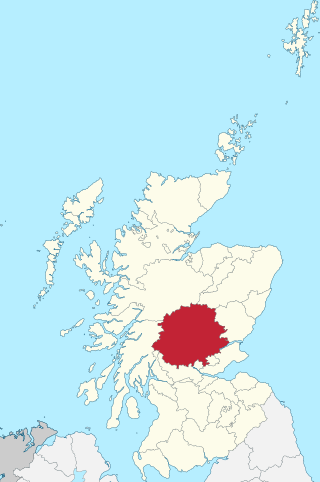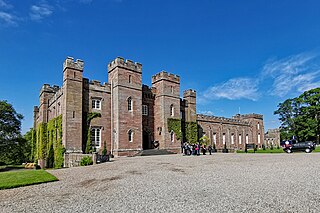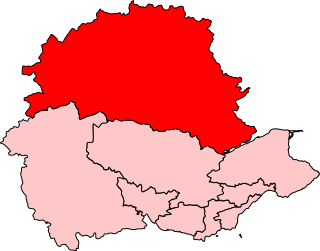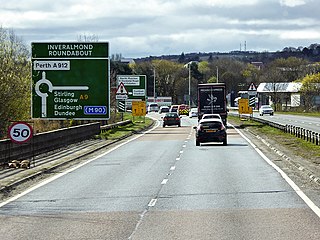
Perthshire, officially the County of Perth, is a historic county and registration county in central Scotland. Geographically it extends from Strathmore in the east, to the Pass of Drumochter in the north, Rannoch Moor and Ben Lui in the west, and Aberfoyle in the south; it borders the counties of Inverness-shire and Aberdeenshire to the north, Angus to the east, Fife, Kinross-shire, Clackmannanshire, Stirlingshire and Dunbartonshire to the south and Argyllshire to the west. It was a local government county from 1890 to 1930.

Perth is a centrally located Scottish city, on the banks of the River Tay. It is the administrative centre of Perth and Kinross council area and is the historic county town of Perthshire. It had a population of about 47,430 in 2018.

Perth and Kinross is one of the 32 council areas of Scotland, and a lieutenancy area. It is bordered by Highland and Aberdeenshire to the north, Angus, Dundee, and Fife to the east, Clackmannanshire to the south, and Stirling and Argyll and Bute to the west. Perth is the administrative centre.
Constantine, son of Cuilén, known in most modern regnal lists as Constantine III, was king of Alba (Scotland) from 995 to 997. He was the son of King Cuilén. John of Fordun calls him, in Latin, Constantinus Calvus, which translates to Constantine the Bald. Benjamin Hudson notes that insular authors from Ireland and Scotland typically identified rulers by sobriquets, noting for example the similarly named Eugenius Calvus, an 11th-century King of Strathclyde.

The County of Kinross or Kinross-shire is a historic county and registration county in eastern Scotland, administered as part of Perth and Kinross since 1975. Surrounding its largest settlement and county town of Kinross, the county borders Perthshire to the north and Fife to the east, south and west.

Alyth is a town in Perth and Kinross, Scotland, five miles northeast of Blairgowrie and about 17 miles northwest of Dundee. In 2016 the town had an estimated population of 2,400.

Aberfeldy is a burgh in Perth and Kinross, Scotland, on the River Tay. A small market town, Aberfeldy is located in Highland Perthshire. It was mentioned by Robert Burns in the poem The Birks Of Aberfeldy and in the Ed Sheeran song The Hills of Aberfeldy.

Errol is a village in Perth and Kinross, Scotland about halfway between Dundee and Perth. It is one of the principal settlements of the Carse of Gowrie. It lies just north of the River Tay. The 2016 population of Errol was estimated to be 1,500 persons, compared to 1,070 in the 2001 Census.

Perth and North Perthshire is a county constituency of the House of Commons of the Parliament of the United Kingdom. It elects one Member of Parliament (MP) by the first past the post system of election. The constituency was created in 2005.

Clan Hay is a Scottish clan of the Grampian region of Scotland that has played an important part in the history and politics of the country. Members of the clan are to be found in most parts of Scotland and in many other parts of the world. However, the North East of Scotland, i.e. Aberdeenshire (historic), Banffshire, Morayshire and Nairnshire Nairn (boundaries), is the heart of Hay country with other significant concentrations of Hays being found in Perthshire, especially around Perth, in the Scottish Borders, and in Shetland.

Dunkeld is a town in Perth and Kinross, Scotland. The location of a historic cathedral, it lies on the north bank of the River Tay, opposite Birnam. Dunkeld lies close to the geological Highland Boundary Fault, and is frequently described as the "Gateway to the Highlands" due to its position on the main road and rail lines north. Dunkeld has a railway station, Dunkeld & Birnam, on the Highland Main Line, and is about 25 kilometres north of Perth on what is now the A9 road. The main road formerly ran through the town, however following modernisation of this road it now passes to the west of Dunkeld.
Luncarty is a village in Perth and Kinross, Scotland, approximately 4 miles north of Perth. It lies between the A9 to the west, and the River Tay to the east.
EastPerthshire was a county constituency of the House of Commons of the Parliament of the United Kingdom from 1885 to 1918. It elected one Member of Parliament (MP) by the first past the post voting system.

Scone is a town in Perth and Kinross, Scotland. The medieval town of Scone, which grew up around the monastery and royal residence, was abandoned in the early 19th century when the residents were removed and a new palace was built on the site by the Earl of Mansfield. Hence the modern village of Scone, and the medieval village of Old Scone, can often be distinguished.

Perthshire North is a constituency of the Scottish Parliament (Holyrood) covering part of the council area of Perth and Kinross. It elects one Member of the Scottish Parliament (MSP) by the plurality method of election. It is one of nine constituencies in the Mid Scotland and Fife electoral region, which elects seven additional members, in addition to the nine constituency MSPs, to produce a form of proportional representation for the region as a whole.

Battleby is a country house in Perth and Kinross, Scotland. It is in the parish of Redgorton, 1 kilometre (0.62 mi) west of Luncarty and 6 kilometres (3.7 mi) north of Perth. The 19th-century house is occupied by Scottish Natural Heritage, and is protected as a category B listed building. The grounds are listed on the Inventory of Gardens and Designed Landscapes in Scotland, the national listing of significant gardens, for their important plant collection.
Cramock Burn is an historic 2.7 mi (4.3 km)-long watercourse in Scone, Perth and Kinross, Scotland. It is a tributary of the River Tay, which it joins just north of where the River Almond flows into the Tay, on the Perth side of the river. On an 1804 estate map, it is described as a "small sluggish stream".

The Cross Tay Link Road is a road-construction project in Perth and Kinross, Scotland. It will link the A93 and A94 roads, near Scone, to the A9 north of the Inveralmond Roundabout, at Perth, via a new stretch of road, 3.7 miles (6.0 km) long. It will involve a three-span bridge over Scotland's longest river, the Tay, hence the project's name. A cycle path will run parallel to the bridge's carriageway.

Public transport in Perth and Kinross is available for two main modes of transport—bus and rail—assisting residents of and visitors to Perth and Kinross, without their own vehicle, to travel around much of the council area's 2,041 square miles (5,290 km2).
















